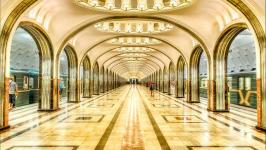The State Hermitage Museum (Winter Palace)
The world's second largest museum after the French Louvre, stunning Hermitage is, indeed, a must-visit for all art enthusiasts from all over the world. The unique Hermitage collections are housed in 6 historic buildings nestled on the Palace Embankment in fairytale St. Petersburg and tells a story of opulence beginning in 1764, when Empress Catherine the Great acquired 225 paintings for her personal collection. Over the next two and a half centuries, this collection was to increase in size to over 3,000,000 exhibits showcasing the development of world culture and art from the Stone Age to the 20th century.
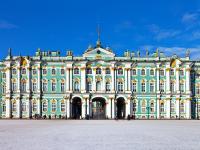
St Issac's Cathedral
St Isaac’s Cathedral dates back to 1707, when it was commissioned by Peter the Great. It takes its name from St Isaac of Dalmatia, whose feast day coincided with the Tsar’s birthday (30th May). The cathedral eventually had to be rebuilt four times: the first version was deemed too modest for the growing city; the second was struck by lightning and damaged by floodwater; and the third was deemed too ugly for its harmonious surroundings.The final version of the cathedral is the structure that we see today,built between 1818 and 1858, by the French-born architect Auguste Montferrand, to be one of the most impressive landmarks of the Russian Imperial capital. The cathedral's facades are decorated with sculptures and massive granite columns (made of single pieces of red granite), while the interior is adorned with incredibly detailed mosaic icons, paintings and columns made of malachite and lapis lazuli. A large, brightly colored stained glass window of the "Resurrected Christ" takes pride of place inside the main altar. The church, designed to accommodate 14,000 standing worshipers, was closed in the early 1930s and reopened as a museum. Today, church services are held here only on major ecclesiastical occasions.
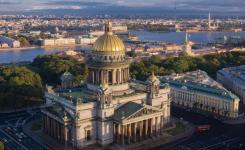
Sergiyev Posad:
Sergiyev Posad is a small town, 71 kilometres from Moscow, which is world-famous as the location of the Trinity St Sergius Lavra Monastery – the spiritual centre of the Russian Orthodox Church. Today, the monastery attracts thousands of pilgrims and tourists – all keen to see the monastery which was founded by St Sergey of Radonezh. He founded on this location a primitive, wooden monastery that ended up being razed by the Tatars shortly after his death. His tomb, however, was left intact, and around it the Trinity Lavra of St. Sergius was built in the 15th century, a monastery that became the most important center of Russian Orthodoxy. Due to the monastery’s enormous wealth, a settlement of merchants (posad) also grew up around it, forming what would become the present day city of Sergiyev Posad.

Arabat Street:
The first historical records of Arbat relate to the year of 1493, the street was mentioned in an account of a major city fire. Most probably, the street name originates from the Arabic world for suburb. In late 19th century a large number of poets, thinkers, musicians and actors inhabited Arbat district. Most of them coming from impoverished noble families shaped Russia's cultural life. During the Soviet times the traditional Arbat inhabitants were eased out by a new class, the functionaries of the Communist Party bureaucracy. In the mid eighties Arbat became the first Moscow’s pedestrian street, the Old Arbat. Over the years the street has developed into one of the most popular places in Moscow. It is alive with street musicians who play music of different genres; with informal movements like Hare Krishna devotees; with artists who are eager to draw your portrait or caricature; with second-hand booksellers whose rows can not be passed unnoticed. Numerous cafes and various restaurants offer the menus to fit any taste and any pocket
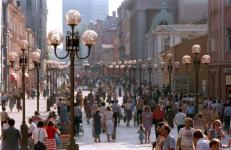
Moscow State University:
Moscow state university is a public research university located near Sparrow hills. Nearly 40000 undergraduate and 7000 postgraduate students study in the university. It has more than 5000 academic staff. It is the second oldest university in Russia since the St. Petersburg University is technically considered as the oldest. Founded in 1755 by Russian scientist and writer Mikhail Lomonosov, the university became one of the most prestigious to study. It is also located in the tallest educational building in the world, in one of the Stalin’s high-risers. The university’s main library is the largest in Russia with more than 5 million books.
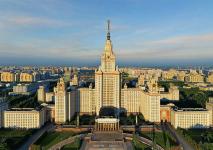
The Moscow Kremlin:
The Kremlin is the heart of Moscow, the origin of the Russian statehood and the most visited tourist attraction in Moscow. The Russian President Residence and the largest acting castle (by territory) in Europe has absorbed the mix of medieval history, unique architecture, orthodox religion, Tsars and Soviet heritage, imperial treasures and many others. Burnt down and rebuilt a several times, the walls were ordered to be upgraded by Ivan III the Great in 1485. The group of Italian architects, the world’s best, decided not to tear them down but to build over them, as a result forming the massive and mighty Kremlin we know today. The most important state ceremonies were held in the Cathedral of the Assumption such as ordination of metropolitans and patriarchs, coronation of tsars and later emperors and public proclamation of state edicts. During its existence the cathedral was decorated with the finest examples of ancient Russian Art, in particular icons from the 12th to 17th centuries. Works of art collected by the grand princes, tsars, metropolitans and patriarchs formed the basis of the state treasury which is now located in the Armory Chamber – priceless manuscripts, art objects fashioned from gold and silver and decorated with precious stones, that were crafted by the best painters, jewelers, engravers and gilders.
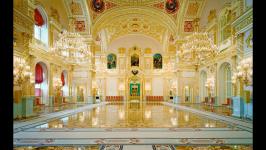
St Basil's Cathedral:
One of Russia’s most recognizable architectural masterpieces is Pokrovsky Cathedral, better known as St. Basil's Cathedral in Moscow. This Orthodox church, which has earned international recognition for its unique beauty, is located in the historical center of Russia’s capital. Its structural distinctiveness evokes endless admiration from tourists around the world and justifiable pride in Muscovites, who are honored to call this world masterpiece their own. The height of St. Basil's Cathedral is 65 meters. For a long time, until the end of the 16th century, it was the tallest building in Moscow. Nine independent temples are built on a single foundation - and are interconnected by internal vaulted passages decorated with ornaments in the form of herbs and flowers. The building is devoid of a clearly expressed facade. Whichever side you approach the cathedral - it seems that it is the main one. The Cathedral was commissioned by Ivan the Terrible to commemorate the capture of the Khanate of Kazan. It was constructed from 1555 to 1561.
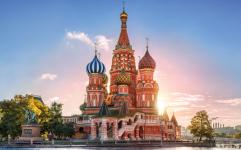
Moscow Metro:
Built during the 1930s, Moscow’s Metro stations were extravagant testaments to the glory of the USSR. Bedecked in marble, elaborate mosaics, frescoes and chandeliers, they were conceived by Stalin as 'palaces for the people'. It's stations are of historic importance, as their architecture was extremely elaborate and used to advance the communist superiority. Moscow Metro is the world's second most heavily used rapid transit system after the Tokyo's twin subway. It has 12 lines and on a normal weekday it carries over 7 million passengers. The first four stages of the metro, built by 1953, are the most beautiful. The dazzling beauty that went into the stations from then on considerably reduced.
